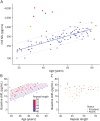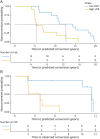Levels of Neurofilament Light at the Preataxic and Ataxic Stages of Spinocerebellar Ataxia Type 1
- PMID: 35264424
- PMCID: PMC9162044
- DOI: 10.1212/WNL.0000000000200257
Levels of Neurofilament Light at the Preataxic and Ataxic Stages of Spinocerebellar Ataxia Type 1
Abstract
Background and objectives: Neurofilament light (NfL) appears to be a promising fluid biomarker in repeat-expansion spinocerebellar ataxias (SCAs), with piloting studies in mixed SCA cohorts suggesting that NfL might be increased at the ataxic stage of SCA type 1 (SCA1). We here hypothesized that NfL is increased not only at the ataxic stage of SCA1, but also at its (likely most treatment-relevant) preataxic stage.
Methods: We assessed serum NfL (sNfL) and CSF NfL (cNfL) levels in both preataxic and ataxic SCA1, leveraging a multicentric cohort recruited at 6 European university centers, and clinical follow-up data, including actually observed (rather than only predicted) conversion to the ataxic stage. Levels of sNfL and cNfL were assessed by single-molecule array and ELISA technique, respectively.
Results: Forty individuals with SCA1 (23 preataxic, 17 ataxic) and 89 controls were enrolled, including 11 preataxic individuals converting to the ataxic stage. sNfL levels were increased at the preataxic (median 15.5 pg/mL [interquartile range 10.5-21.1 pg/mL]) and ataxic stage (31.6 pg/mL [26.2-37.7 pg/mL]) compared to controls (6.0 pg/mL [4.7-8.6 pg/mL]), yielding high age-corrected effect sizes (preataxic: r = 0.62, ataxic: r = 0.63). sNfL increases were paralleled by increases of cNfL at both the preataxic and ataxic stage. In preataxic individuals, sNfL levels increased with proximity to predicted ataxia onset, with significant sNfL elevations already 5 years before onset, and confirmed in preataxic individuals with actually observed ataxia onset. sNfL increases were detected already in preataxic individuals with SCA1 without volumetric atrophy of cerebellum or pons, suggesting that sNfL might be more sensitive to early preataxic neurodegeneration than the currently known most change-sensitive regions in volumetric MRI. Using longitudinal sNfL measurements, we estimated sample sizes for clinical trials with the reduction of sNfL as the endpoint.
Discussion: sNfL levels might provide easily accessible peripheral biomarkers in both preataxic and ataxic SCA1, allowing stratification of preataxic individuals regarding proximity to onset, early detection of neurodegeneration even before volumetric MRI alterations, and potentially capture of treatment response in clinical trials.
Trial registration information: ClinicalTrials.gov Identifier: NCT01037777.
Classification of evidence: This study provides Class III evidence that NfL levels are increased in both ataxic and preataxic SCA1 and are associated with ataxia onset.
© 2022 American Academy of Neurology.
Figures






Comment in
-
Neurofilaments as Decay Rate Biomarker in Spinocerebellar Ataxia Type 1: Highlighting Key Questions of Application and Future Challenges.Neurology. 2022 May 17;98(20):821-822. doi: 10.1212/WNL.0000000000200360. Epub 2022 Mar 9. Neurology. 2022. PMID: 35264423 No abstract available.
References
-
- Robitaille Y, Schut L, Kish SJ. Structural and immunocytochemical features of olivopontocerebellar atrophy caused by the spinocerebellar ataxia type 1 (SCA-1) mutation define a unique phenotype. Acta Neuropathol. 1995;90(6):572-581. - PubMed
-
- Rüb U, Schöls L, Paulson H, et al. Clinical features, neurogenetics and neuropathology of the polyglutamine spinocerebellar ataxias type 1, 2, 3, 6 and 7. Prog Neurobiol. 2013;104:38-66. - PubMed
Publication types
MeSH terms
Substances
Associated data
LinkOut - more resources
Full Text Sources
Medical
Research Materials
